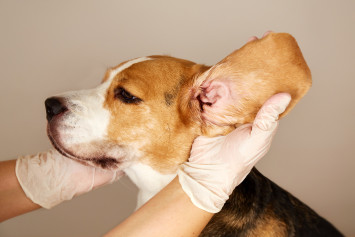
An ear infection is one of the most common infections your dog can get, and they can be uncomfortable, too. That’s why it’s so important to understand what a dog ear infection looks like, how to treat it, and what recurrent ones could mean about your dog’s overall health. What Are the Causes and Types of Dog Ear Infections? Let’s just start with saying that the ear canal is the perfect breeding ground for an infection. It’s dark and it’s warm. Normally, your dog’s immune system helps to keep that perfect breeding ground balanced so that bacteria or yeast can’t take over, but if something were to throw that balance off, redness, itchiness and discharge may ensue. So, what kinds of things throw that balance off?
Allergies: Food or environmental allergies in dogs can be a common cause of ear infections due to the immune system’s response. If your dog is experiencing recurrent ear infections or those that won’t go away despite treatment, allergies may be to blame.
Foreign Bodies: Dogs love sticking their nose (and sometimes whole head) into things, allowing foreign bodies like grass seeds to get into the ear canal. Once there, foreign bodies can elicit inflammation—and an infection.
Polyps or Masses: Similar to foreign bodies, polyps or masses in the ear canal can lead to inflammation and a bacterial or fungal overgrowth.
Moisture: The only thing that would make an ear canal more perfect for an infection is moisture. Getting water into the ears during bathing, swimming, or walks in the rain almost guarantees an ear infection for many pups.
Breed Dispositions: For dogs with erect ears, getting fresh air to the ear canal is easy-peasy. This fresh air can help remove moisture and make ear infections less likely. For dogs with floppy or hairy ears, the ear canals rarely see the light or freshness of day, making ear infections more likely. Breeds predisposed to allergies, such as Labs or Cocker Spaniels, may also see more than their share of ear infections.
Types of Dog Ear Infections
A dog ear canal has three sections, all of which are capable of breeding an infection. That means that a dog can come down with three different types of ear infections based on where the problem is residing.
Otitis externa is by far the most common type of ear infection. This is an infection of the outer part of the ear, basically from the ear drum out. This area is open to the outside world, so it has the chance of coming across issues more commonly.
Otitis media is an infection of the middle ear and usually occurs due to extension for a particularly nasty or untreated case of otitis externa.
Otitis interna is an infection of the inner ear, or the deepest part of the ear canal. Infections here can occur along with otitis media.
Otitis media and otitis interna are very rare in dogs, but it may help to know what to watch out for just in case.

What Are the Signs of Ear Infections in Dogs?
Dogs are typically pretty forthcoming when it comes to what does a dog ear infection looks like. They don’t try to hide that they have a problem. Signs of ear infections in dogs may include:
Headshaking and Scratching
What you’ll usually see first and foremost (and often) is lots of headshaking and scratching at their ears. It’s about all they can get done in a day. Scratching may become so severe that they create wounds at the base or on the outside of their ears. You may also see them rub their head on the floor or against your leg to relieve the itch.
Redness, Swelling, and Pain
Once the headshaking and scratching alerts you to a problem, the next thing you’ll notice is redness and swelling of the inside of the ear. The ear may also feel warm to the touch and your pup may be sore and not like you handling it.
Ear Discharge and Odor
Along with the redness and swelling, you’ll probably notice some discharge in the ear canal. This typically looks greasy and dark but may also be flaky and lighter colored. It often also smells bad and you may notice the odor when being near your dog, let alone with you lift up their ear flap.
Head Tilt or Incoordination
Your dog may also hold their head tilted to affected side, especially with otitis media and interna. They may also act uncoordinated and keep circling to the affected side.
How Are Dog Ear Infections Diagnosed and Treated?
Even though you may recognize the signs of ear infection in dogs, maybe from previous experience, maybe from this article—you'll still want to enlist the help of your veterinarian for diagnosis and treatment.
Diagnosing an Ear Infection
Using an otoscope, your vet will be able to get a look down into the ear canal to check on the ear drum and look for foreign bodies, polyps, or masses. Your vet will also be able to take a bit of the discharge and look at it under the microscope. This is important to determine if bacteria or yeast are the main culprits, which can sway the treatment that your vet chooses. They can also check for ear mites, a possible but less likely cause of dog ear infections. If this is your dog’s first offense and they have a good reason for brewing up an ear infection, such as recent bath or swimming escapade, the diagnosis will likely stop there. However, if your dog is a repeat ear infection offender, your vet will probably dive into underlying causes. This may include blood tests, allergy tests, or elimination diets.

Treatment for a Dog’s Ear Infection
Once your dog’s ear pain is diagnosed, your vet will recommend treatment. This often includes some type of ear cleaning along with topical or oral medications. Ear cleaning and medications are usually given twice a day for a week or more depending on the severity of the ear infection. Infections in the middle or inner ear will require oral medications.
You shouldn’t attempt treatment without a proper veterinary diagnosis. Putting liquids like ear cleaner or medications into a dog’s ear that has a ruptured ear drum can lead to otitis media or interna that are more difficult to treat and can cause damage to the ear.
Some dogs with chronic ear infections may require surgery to remove the infected tissue in the ear canal and to clean out the middle ear, if necessary, so that ear infections can longer take hold.
Can Dog Ear Infections Be Prevented?
Once you know the causes of dog ear infections and what they look like, you’re better prepared to prevent them. One of the best ways to do so is with regular ear cleaning. Depending on your pup, you may want to make this part of your dog’s weekly grooming regime, making sure to clean after baths, swimming or any time your pup gets their head wet.
You also want to see your veterinarian regularly. They’ll be the ones able to get a look inside those ear canals to hopefully catch a small infection before it comes on full bore. Vets are also your best line to address underlying health conditions, such as allergies, that are more likely to put your pup in line for a lifetime of dog ear pain.
Along with regular veterinary checkups should come dog health insurance. Having your pet covered as soon as possible may help pay for some of those ear infection treatments, as well as other medications and procedures. Just make sure you know how pet insurance works as most don’t cover pre-existing conditions which could be an issue for chronic ear infection sufferers. Be sure to get your pup enrolled as early as possible so that any ear infections that may come your way are fully covered.
Are There Any Potential Complications of Untreated Ear Infections?
We already mentioned a few of the consequences of not getting your dog’s ear infections under control—the extension of the infection into the middle or inner ear. This comes as a result of rupturing the eardrum, or tympanic membrane. Untreated infections in these areas can lead to permanent hearing loss.
Another potential issue with not treating dog ear infections is all of that shaking and scratching can lead to an aural hematoma. This painful, blood-filled swelling may require surgery to treat, making pet insurance a great partner to help cover the costs.
Should You Worry about Dog Ear Infections?
Ear infections in dogs are common enough that every pet owner should know the signs so that they can get a diagnosis and treatment plan as soon as possible. Not only will this help make treatment easier and avoid potentially permanent issues, it also means that your dog will be free of the pain and discomfort sooner to move on with their happy and healthy life.
Have you ever witnessed the pure joy on a dog's face when they hear the crinkle of their favorite treat bag? Or the moment their ears twitch excitedly at the sound of your approaching footsteps? Healthy ears are the gateway to a world of wonder for our canine companions. By prioritizing their ear health, we ensure they can continue to experience the full spectrum of life's adventures – big and small – with every twitch, perk, and tilt of their head. So, let's take good care of those floppy, twitchy, wonderful ears, because they're a big part of the special connection we share with our four-legged best friends.